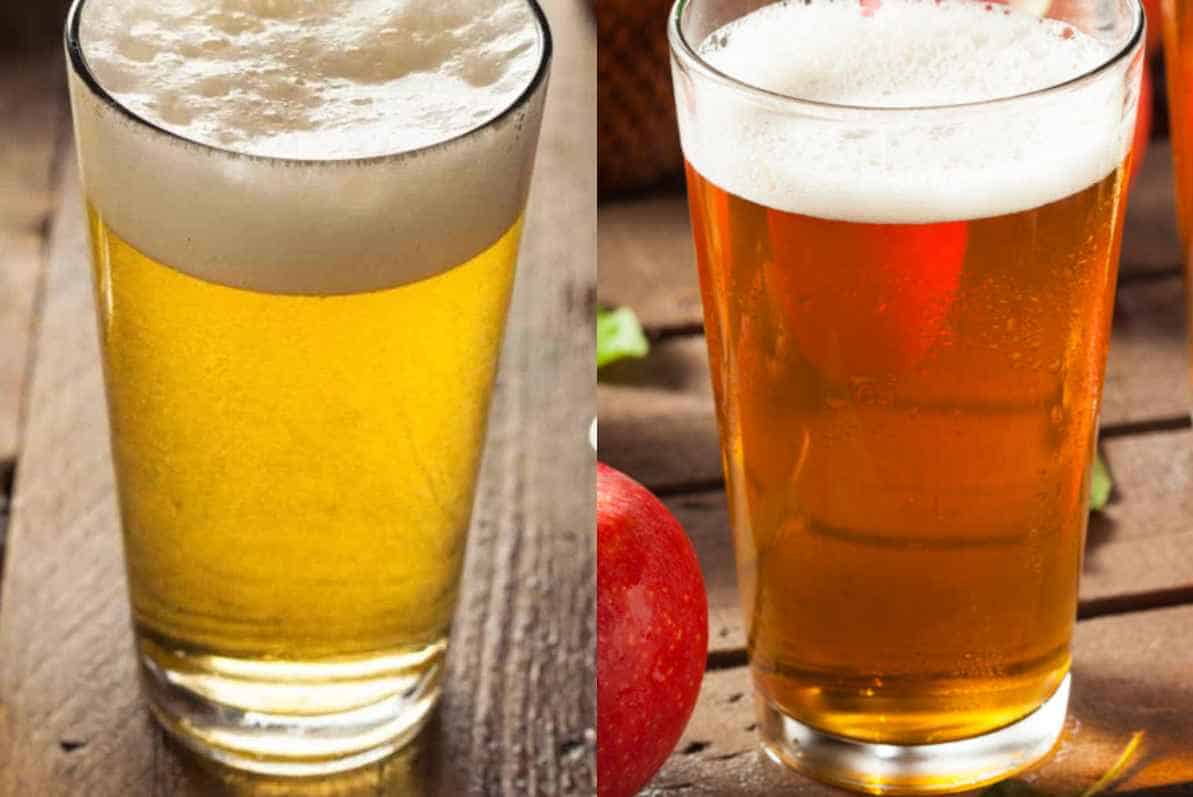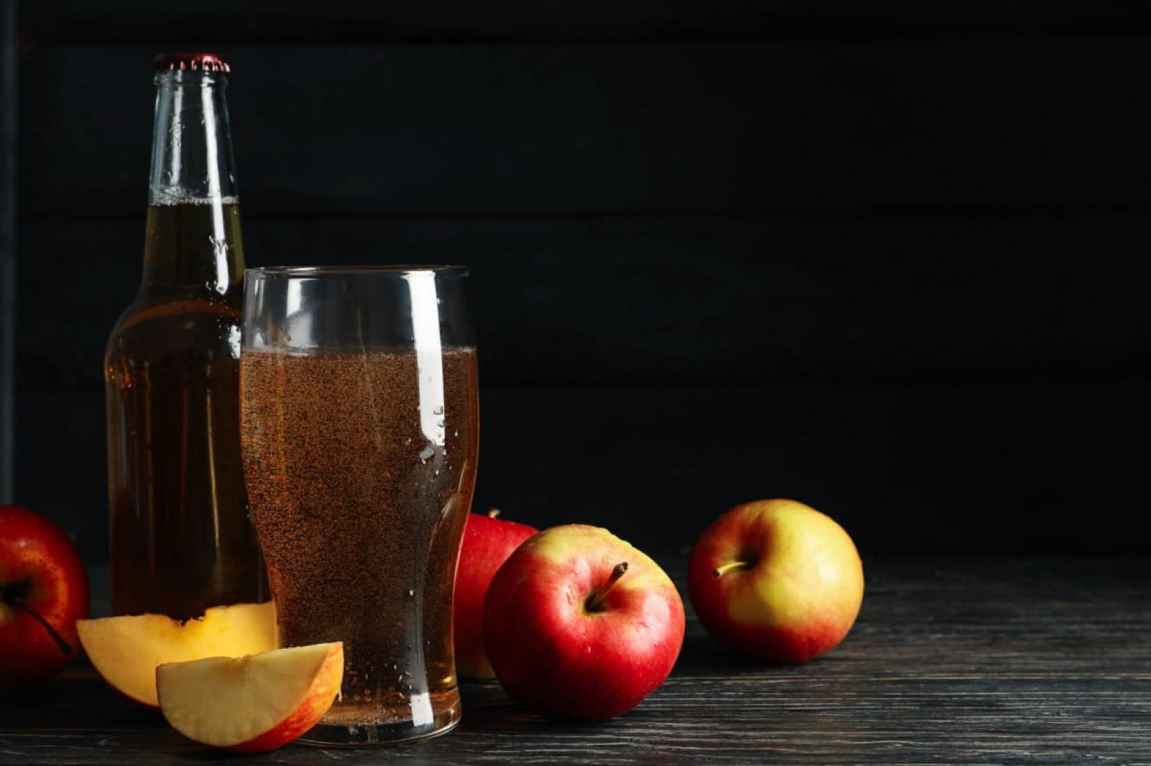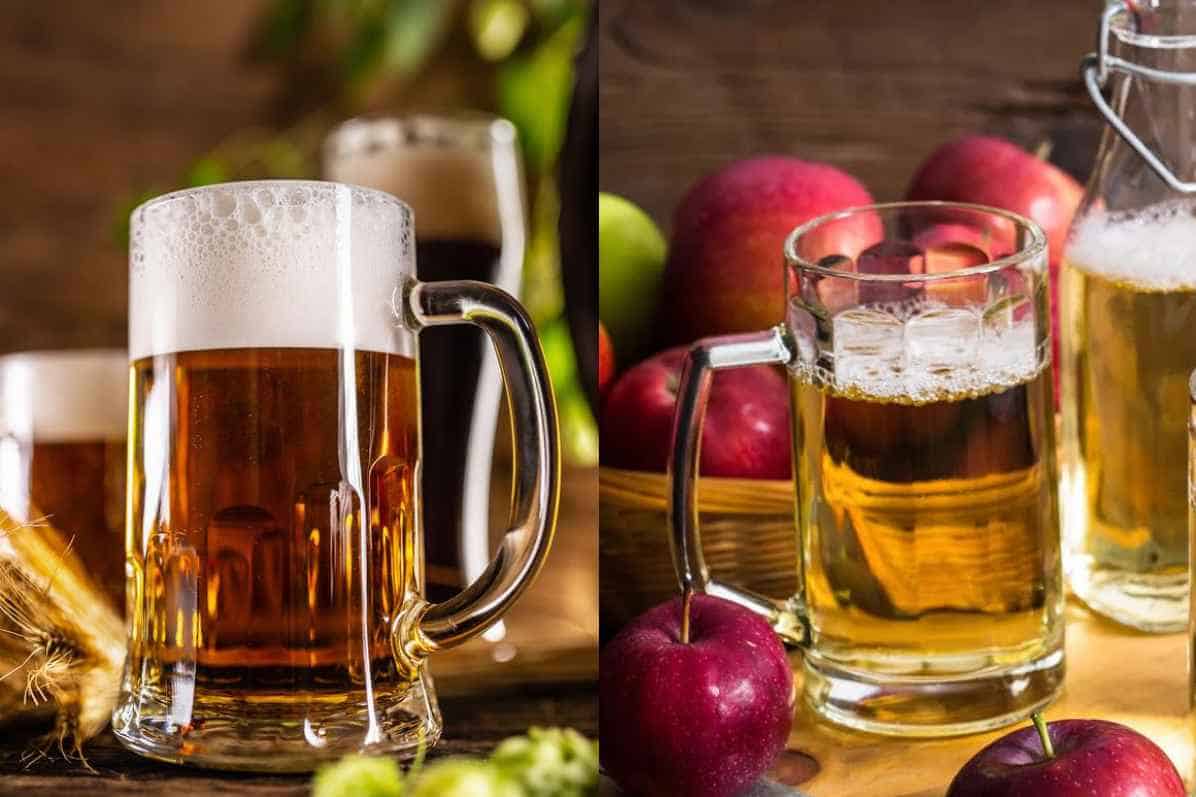When presented with beer and cider, which one would you choose? Picking one can be tricky since both of them are delicious and refreshing.
They may have different ingredients, brewing processes, and taste profiles, but they are both delightful beverages. Who wins in the beer vs. cider battle? Which is healthier? Read on to find out what sets each one apart so you can make your choice.
A Look Into Beer vs. Cider
So, how does cider compare to beer? Here’s a quick look at the differences between these two favorite drinks.
Beer vs. Cider: A Quick Look
| Beer | Cider | |
| Common Ingredients | Barley, hops, water, and yeast | Apple and yeast |
| Major categories | Three: ale, lagers, and hybrid | Two: Cider and hard cider |
| Gluten | Not naturally gluten-free | Naturally gluten-free |
| Sugar content | Low | Very high |
| Calories/ 12 oz | 150-200 calories | 120-170 calories |
| Typical ABV range | 4-6% | 1.2 -8.5% |
| Flavor Profile | Herbal, floral, and bitter | Sweet and fruity |
| Offers non-alcoholic version? | yes | yes |
What’s the difference between beer and cider?
Suppose you’re at a party and someone offers you a beer and a cider. Which one will you choose? Would there be a distinct difference between the two?
These two well-loved beverages have different main ingredients. Beer is primarily made from barley, yeast, and water. Brewers add hops to the mixture for flavor, aroma, and bitterness. These ingredients also give beer that all-familiar scent.
On the other hand, cider is a fermented beverage that comes from apples or apple juice. The result of the manufacturing process is a sweet and fruity drink. So, if you’re fond of apple juice, then cider is the best choice.
How are beer and cider similar?
Beer and cider may share differences, but they also have the following similarities.
Both these drinks can give you a buzz from alcohol
On average, beer has 4-7% alcohol content but can go as high as 40%. On the other hand, hard cider’s alcohol level can go as low as 1.2 and high as 8.5%.
Both of them have non-alcoholic versions
Suppose you’re not into alcoholic beverages but would love to enjoy the refreshing flavors of beer and cider. Don’t worry because there are non-alcoholic beers and regular cider. These two non-alcoholic versions may not have alcohol but they still taste great.
Both beer and cider go through fermentation to produce alcohol
They also undergo additional processes such as filtering, carbonation, and aging.
Both drinks are best served chilled
These two beverages are often served cold and can be enjoyed in many situations. They’re usually fun to drink in a bar, restaurant, or at home.
Both share similar tasting notes
While beer and cider can vary in terms of flavor, both can have similar notes of sweetness and bitterness. The overall flavor profile will depend on their ingredients and the brewing process.
Beer vs. Cider: Differences in How They’re Made
The distinct flavors of beer and cider are due to their manufacturing process. Both drinks go through fermentation. However, there are variations in the primary ingredients and the additional processes.
Ingredients
The main difference between beer and cider ingredients is the type of fermentable sugars used to make the alcohol. Beer is typically made from barley, hops, water, and yeast.
The barley is mashed and boiled to release the sugars. Then it’s fermented by yeast to produce alcohol. Hops are added for flavor and aroma and sometimes to balance the sweetness of the malt.
On the other hand, cider comes from crushed apples (or sometimes other fruits) and yeast. The juice goes through yeast fermentation to produce alcohol.
Unlike beer, cider does not contain hops, and the sugar comes from the natural sugars in the apples. Some ciders may also include additional sweeteners, spices, or flavorings to enhance the taste.
Brewing Process
Both beer and cider are fermented alcoholic beverages. However, the brewing processes are quite different. There are variations in raw materials, processing, and techniques used to produce the final product.
Mashing and boiling
The barley goes through mashing to release the sugars in the beer-making process. Then, the brewers boil them with hops to extract the flavor and aroma. Cider does not undergo mashing or boiling, as the juice from the apples is fermented directly without additional processing
Fermentation
Both beer and cider undergo fermentation, in which yeast consumes the sugars and converts them into alcohol. However, the types of yeast used in beer and cider are different, and the temperature, duration, and process of fermentation can also vary.
Clarification
Beer is typically filtered to remove solids and yeast, while cider is often left unfiltered for a cloudy appearance and a fuller flavor.
Carbonation
Beer is often carbonated through a secondary fermentation in the bottle or in a pressurized tank, while cider is sometimes carbonated through a similar process or by injecting carbon dioxide directly into the cider.
Purpose
People drink beer primarily for its intoxicating effects and as a socialization tool. It is often associated with casual drinking and social gatherings, such as parties, barbecues, and sporting events.
Conversely, cider is often consumed as a refreshing alternative to beer, wine, or spirits. Some enthusiasts viewed it as a lighter or sweeter option. It is often more enjoyable during warmer months or outdoor activities.
Beer vs. Cider: Comparing their Sensory Profiles
The flavors of cider and beer can be different and depend on various factors, including the type of ingredients used, the brewing process, and the yeast strain.
Flavor Profile
Beer can have a wide range of flavors due to its ingredients and brewing process. Hops, a vital component in beer, can contribute bitterness and floral and herbal notes to the beer. Some beers are light and refreshing, with a clean, crisp flavor, while others are dark and malty, with chocolate, coffee, or roasted malt notes.
On the other hand, apples (or other fruits) give cider a fruity, sweet, and crisp flavor. Its sweetness can range from very dry to very sweet – depending on the type of apples used, and the sweeteners added.
Cider can also have a range of flavors, including floral, spicy, and earthy notes. The taste can also result from the brewing process and the additional ingredients.
Alcohol Content
Generally, beer has higher alcohol content than cider. However, each type presents varying alcohol levels depending on the brand or variant.
Typically, beer’s alcohol by volume (ABV) ranges from 4% to 14% The most common beer types fall within the 4% to 6% ABV range. However, some brewers make specialty beers, such as imperial stouts or barley wines, with a significantly higher alcohol content. They can reach up to 20% ABV or more.
On the other hand, cider usually has an alcohol content that ranges from 4% to 8% ABV, although some ciders can have an alcohol content as high as 15% ABV or more.
Appearance
Beer and cider can differ in appearance, although some of their physical features overlap.
Beer comes in many colors, from pale gold to dark brown. The beer type and brewing process dictate the drink’s clarity or cloudiness. Some beers, such as hefeweizens or witbiers, are known for their hazy, cloudy appearance. Meanwhile, other beer varieties, such as pilsners or IPAs, are typically clearer.
Conversely, cider is usually golden or light brown. It is generally clear, although some ciders can be slightly cloudy. Some carbonated varieties may possess champagne-like bubbles.
Beer vs. Cider: Which is a Healthier Option
Technically, neither beer nor cider is a “healthy” option. Both drinks have alcoholic versions, and drinking too much alcohol is not good for your health. Some health-conscious drinkers may choose one over the other based on their caloric or sugar content.
Calories
Most beers have higher calories compared to cider. A 12-ounce beer can or bottle can go from 150 to 200 calories. Meanwhile, a 12-ounce serving of cider typically has around 120 to 170 calories. However, it’s important to note that calorie content varies depending on the drinks’ variety and alcohol content.
Sugar
The sugar content of beer and cider can vary widely. It depends on the drink’s type, brand, and brewing process. However, cider tends to have more sugar than beer on average.
Beer is typically made from barley, wheat, rye, and hops- ingredients with small amounts of sugar. Some beers may have a small amount of residual sugars from the brewing process. However, the sugar content is negligible.
On the other hand, cider comes from fermented apple juice, which contains natural sugars. Additionally, some ciders have additional sweeteners to enhance the flavor. As a result, the sugar content of cider can be significantly higher than beer. A 12-ounce serving of cider can contain anywhere from 10 to 25 grams of sugar. The average content is around 15 grams.
Gluten
Generally, beer is not gluten-free due to its barley content. However, brewers are now offering gluten-free options, including beer made from oats, rice, and buckwheat.
On the other hand, most ciders are gluten-free since they’re typically made from apples. But, some manufacturers add malt to ciders for added flavor. This ingredient makes some ciders not gluten-free.
It’s always best to check the ingredients list and contact the manufacturer to confirm if your drink has gluten. It’s a crucial step, especially if you have celiac disease or gluten intolerance.
Conclusion
In the “battle” between beer vs. cider, there isn’t really a definite victor. Each one has its own merits that can delight consumers. It all boils down to a person’s taste preferences.
The important thing to remember is to drink beer and cider in moderation. Both drinks can be a refreshing summer treat or the star of any celebration.

As a homebrewer, Michael would get frustrated about the lack of brewing information on the internet. After hundreds of gallons of spoilt batches, Micheal had enough. And he founded Unknown Brewing as a resource for homebrewers.




